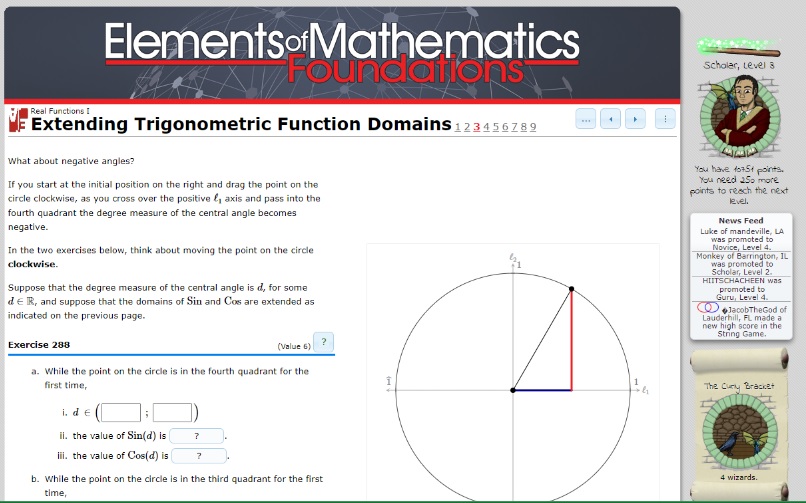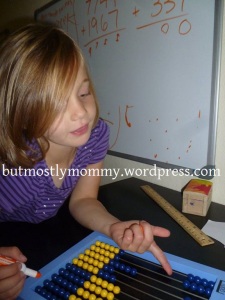About two years ago, Peatie hit a wall in math. He had been using and enjoying Art of Problem Solving materials for years, completing Beast Academy 3-5 and (to my surprise) enjoying the hefty tome that is AoPS PreAlgebra. But partway through the Intro to Algebra book, something just wasn’t clicking: some chapters he could breeze through with ease, while others just didn’t seem to make sense for him.
Of course, I did what any sane homeschooling parent would do: I panicked. Peatie has loved math since the time he first discovered that he could count his fingers, and back in kindergarten he was clear enough on his preferences to inform me, “I want HARD math, Mommy!” In fact, math is one of the few areas in his life where he seems to thrive on challenge–but he was no longer thriving with the challenge of Art of Problem Solving, and my math skills were too rusty to be of much help. But the general consensus of everyone on the internet is that if you want your kid to have the best, most challenging math, AoPS is the way to go. I was clearly failing my child!
In the midst of this weeks-long panic, I somehow ran across a mention of the Institute for Mathematics and Computer Science (IMACS) and their challenging middle school curricula, Elements of Mathematics: Foundations. I could find very little information about the course, but what little I found seemed promising. Noting that the first course (of 18, intended to cover a three-year period) was offered for free, I thought I’d let Peatie try it out. He loved it!

For the past two years now, Peatie has been working through EMF courses. Since I still rarely see these mentioned online, I thought maybe someone would benefit from a review of them.
EMF consists of 18 courses of varying lengths, intended to take a middle school student through what’s traditionally considered Prealgebra, Algebra 1, Algebra 2, Geometry, and Precalculus over the course of three years.
There are a few downsides to this curricula:
- While there are in-person classes for those local to IMACS, most of the world would be accessing these classes via the internet. You need a reliable internet connection with speed adequate for downloading the videos in order to do this course. If your internet goes down, you’re outta luck.
- The symbols and terminology used in this program are so vastly different than those in traditional math classes that parents will likely be able to offer very little help if their student is stuck. Sometimes my son simply needs me to stand in the room as a sounding board, and sometimes I can offer suggestions like, “Why don’t you start over? There’s a chance you made a mistake that you aren’t noticing.” Other than that, I’m not much use. There is a help forum available, and many questions have a little “?” icon with past students’ questions and the suggestions offered to them, but some kids might find this to be too little direct assistance if they’re used to a solution manual or the possibility of parent assistance.
- Because this program is so different from others, there’s no way to start midway through the program. Every student must start from the very first course. This caused me some hesitation: Peatie had already completed a very solid Prealgebra course and was most of the way through what would be considered Algebra 1. It felt like I would be consigning him to repeat old material and generally slowing his progress by having him start over. I eventually came to my senses, reminding myself that education isn’t a race and it would be far better for him to repeat material and know it very well than to rush ahead just so he could complete Calculus as a high school freshman (and why?). For all my agonizing, he had no complaints about what he was doing. Despite the fact that the first courses he was taking were part of a “Pre-Algebra Plus Course Pack,” the approach and scope were so vastly different from what he’d been doing (with titles like “Operational Systems,” “Ordered n-Tuples,” and “Number Theory”) that it didn’t feel at all like repetition.
- The pacing for this program is a challenge. Though you know how many courses they expect you to complete in a traditional school year, some courses are much longer or more complex than others, so being halfway through the courses might not mean that you’re halfway through the curriculum. For the first year, IMACS offers a week-by-week progress guide to help the students pace themselves. After that, however, there’s no more guidance offered. While I realize that it’s wonderful to work at your own pace, it’s nice to have some idea how long the course creators expect the material to take. Particularly since my son is a slow worker who is easily side-tracked by his ADHD, it’s nice to have a goal to help him stay on track (and give me an idea whether those three pages took him all week because the problems were especially hard or because he got distracted by the graphing process).
- It’s not inexpensive. Currently the courses are listed at $60 apiece, which adds up in a hurry; HOWEVER, you can save a lot by buying a “Course Pack,” which bundles all the courses for one year into a single purchase. (The first year, made of Courses 1-9, rings up at $360, while the next two years are around $250 each.) That said, if you’re considering getting instructional help for AoPS, even their self-paced courses are $460 per semester–not including textbooks–at which point $350 per year doesn’t sound so bad.
Those were the drawbacks: now for the positives of EMF.
- It’s less expensive than many of the alternatives. I researched online AoPS instruction, both from AoPS itself and from other providers, and I couldn’t find classes from institutions I’d heard of for less than $800/year. (I did find an obscure provider offering $25/month classes, but I was concerned about paying $200–plus the cost of the book–for an instructor I knew nothing about.) Local math tutors offered services starting at $25/hour. Again, even $350 sounded like a bargain compared to the alternatives.
- It’s challenging. My son is thriving because EMF is stretching him to think of math in new ways, and he’s loving it. Though AoPS is an excellent program, it’s not the only amazing program out there.
- It’s fun. While EMF has a lot of text, similar to AoPS, there are also silly little videos (okay, mostly audio) featuring students and a professor discussing the concepts that are being taught. My son enjoys the humor these characters add to the learning process, and he gets a kick out of the fact that he can “level up” as he learns. In addition, EMF sprinkles in silly problems (similar to AoPS) and offers interactive elements so you can better visualize the math you’re doing. (The one downside: sometimes my ADHD son gets so into testing different things with these interactive models that he completely loses track of time.)
- Remember how I mentioned that I couldn’t really help my son with math because the symbols and terminology are so different? While that’s a drawback, it’s also a positive. Because he can’t expect me to rush over and clarify, Peatie has had to become a little more independent. For a child who loves my apron strings, this has been great. He’s learned to re-read confusing passages, look up terms in the index, re-work incorrect problems, and check out the help forum–all skills that will serve him well as he faces challenging courses in the future. And the fact that he’s experienced success in problem-solving has bolstered his confidence that he can do this on his own.
- It seems to be effectively developing his understanding of math. I have my kids take a standardized test each year to make sure they’re comfortable with the format of major tests and give me information about their strengths and weaknesses. Last year I had Peatie take the MAP Algebra 1 test, figuring that even though he was still finishing Pre-Algebra in EMF, he’d already taken most of Algebra 1 through AoPS. This year I was scratching my head at what to do: I didn’t feel like he should re-take the Algebra 1 test that he’d done well on, but he technically hadn’t completed the Algebra 1 material in EMF and hadn’t even touched on Geometry yet. In the end, I signed him up for Algebra 2 and told him to do his best and not worry about it. He scored in the 98th percentile on the test, despite technically still being in the middle of Algebra 1.
Well, that’s all that I can think of for now. I hope that this report is helpful to someone else who is looking for a challenging math alternative to AoPS.


